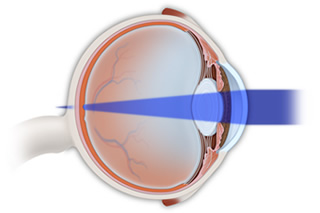Eye Conditions
Dry Eye
Dry eye is a common condition that occurs when the eyes are insufficiently moisturized, leading to itching, redness and pain from dry spots on the surface of the eye. The eyes may become dry and irritated because the tear ducts don’t produce enough tears, or because the tears themselves have a chemical imbalance.
Patients with this condition often experience irritating symptoms and can suffer from more serious vision damage if this condition is left untreated. It is important for patients with this condition to take special care of their eyes in order to alleviate symptoms and prevent complications. Your doctor can diagnose dry eye during a comprehensive eye examination and by using ancillary tests to measure tear production such as a Schirmer tear test.
Ectropion and Entropion
Ectropion is a disorder in which the eyelids tend to turn outward, exposing the underside of the eyelid and leaving it vulnerable to infection. This problem can be caused by aging, facial nerve paralysis, a congenital birth defect, or scar tissue from previous trauma. This may be accompanied by or contribute to the formation of ailments such as conjunctivitis, interstitial keratitis, and excessive dryness of the eyes. Some of the symptoms may be treated with lubricating eye drops, but if the eyelid continues to turn outwards of its own accord, a surgical tightening of the muscles may be required.
Entropion is a disorder in which the eyelids tend to turn inward, causing irritation of the eye. It can be caused by a congenital defect, aging, spasm, inflammation from other ocular disorders or scars from previous trauma. The cornea can be severely agitated if this is not corrected. Treatment consists of a brief surgical procedure under localized anesthesia.
Farsightedness
 Hyperopia, also known as farsightedness, is a condition of the eyes where the focus on distant objects is better than the focus on objects closer to the eye, so nearby objects appear out of focus. The eye is designed to focus images directly on the surface of the retina; with hyperopia, light rays focus behind the surface of the retina, producing a blurry image.
Hyperopia, also known as farsightedness, is a condition of the eyes where the focus on distant objects is better than the focus on objects closer to the eye, so nearby objects appear out of focus. The eye is designed to focus images directly on the surface of the retina; with hyperopia, light rays focus behind the surface of the retina, producing a blurry image.
Hyperopia may be caused by the following:
- The eyeball is too small
- The focusing power of the eyeball is too weak
- A family history
Symptoms of hyperopia may include:
- Vision that is blurry when looking at close objects
- Eye strain
- Headaches when reading
- Strabismus symptoms in children
- Pain in the eyes
Hyperopia can be treated in a variety of ways. The most common is:
- Prescription reading glasses
- Prescription contact lenses
Hyperopia can also be treated with invasive or non-invasive surgical procedures, including:
- PRK (photorefractive keratectomy)
- LASIK (laser-assisted in situ keratomileusis)
Fuchs’ Dystrophy
Fuchs’ dystrophy is a rare degenerative disorder which causes the cells of the inner cornea to slowly deteriorate. The cells lose their ability to move excess fluid away from the field of vision, causing vision to become cloudy or blurry in the morning and get progressively better throughout the day. Other symptoms may include:
- Dry, gritty sensation in the eyes
- Poor night vision
- Halos around lights
- Sensitivity to bright lights
- Sharp pain in the eyes
Although the symptoms of Fuchs’ Dystrophy can be treated, the actual defect of the eye cannot be cured. If caught in the early stages, several simple maneuvers can be performed on the eyes, such as using a blow dryer at arm’s length or saline solution in order to reduce the fluid buildup. Wearing soft contact lenses may also help alleviate discomfort. Once the disease has progressed to the point at which daily life becomes difficult, the doctor may suggest a corneal transplant (keratoplasty) to replace the deteriorated cornea(s).
Glaucoma
Glaucoma is the leading cause of blindness and visual impairment in the US, and can affect patients of all ages, many of whom do not experience any symptoms and may not be aware that they have the disease. Glaucoma actually refers to a group of diseases that cause damage to the optic nerve as a result of increased pressure within the eye, but it can also be caused by a severe eye infection, injury, blocked blood vessels or inflammatory conditions of the eye.
There are two main types of glaucoma: open-angle and angle-closure. Open-angle glaucoma is the most common type of glaucoma and involves fluid in the eye not draining properly through the trabecular meshwork. Angle-closure glaucoma involves a sudden buildup of pressure in the eye due to poor drainage because the angle between the iris and the cornea is too narrow.
Many patients do not experience any symptoms during the early stages of glaucoma, including no pain and no vision loss. This makes it difficult for many patients to know if they have the disease. But as glaucoma progresses, patients may experience a loss of peripheral or side vision, along with sudden eye pain, headache, blurred vision or the appearance of halos around lights.






